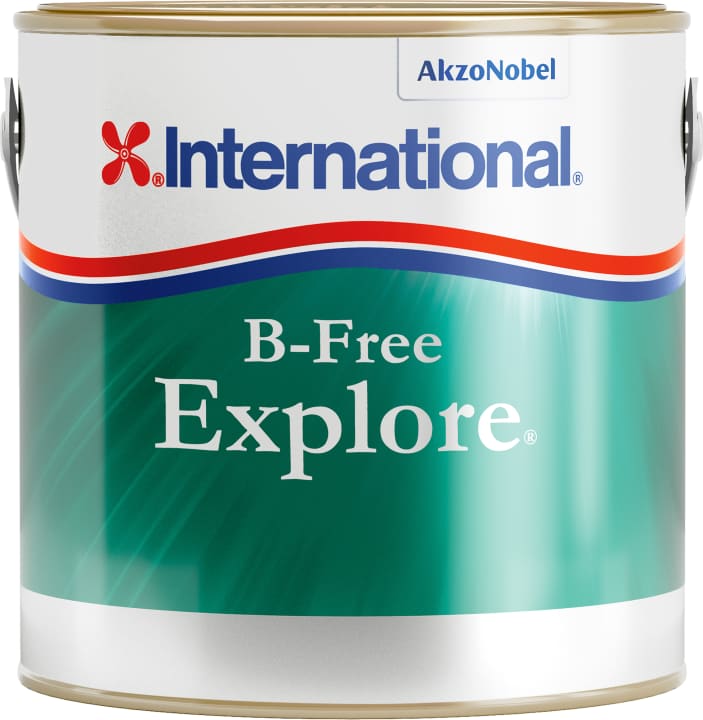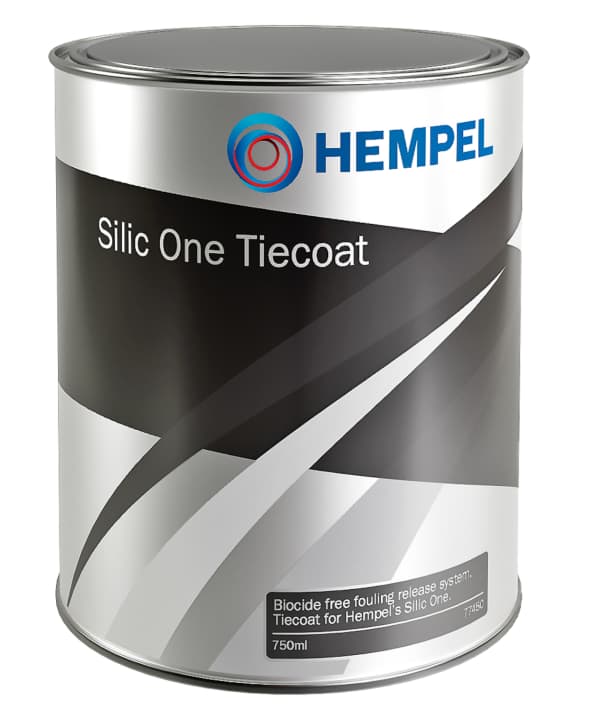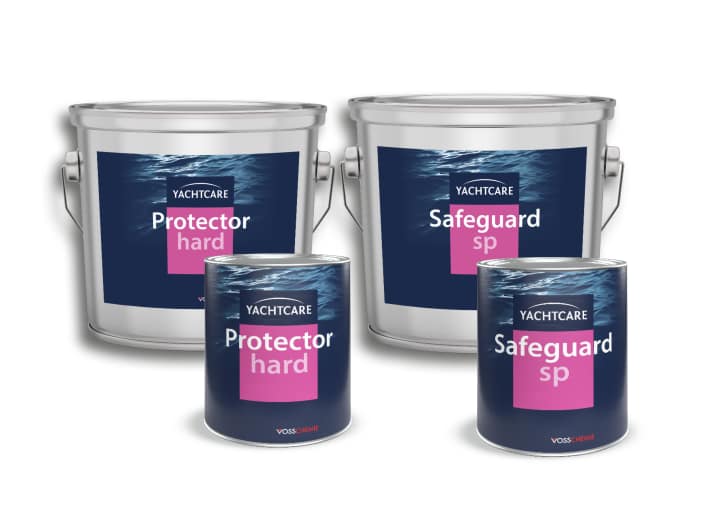
Commercial shipping is a pioneer in the development of biocide-free alternatives. Here, fouling has a huge impact on fuel costs. The shipping industry is also interested in a green image. "We have been discussing the introduction of microplastics for self-polishing yacht antifoulings with shipowners for a long time," says Thomas Zeller from paint manufacturer International.
The majority of cruisers are now coated with so-called fouling release systems. Instead of poisoning the fouling, a smooth and slippery surface is used, which makes it more difficult for pox and algae to take hold. Fouling can form if left for long periods. However, this adheres so poorly that it is washed off when the boat is underway. The underwater hull is therefore self-cleaning.
Manufacturers are working on antifouling alternatives
The first attempts to use this silicone-based technology on yachts were made around 15 years ago. However, the coating did not provide the desired effect by far and was also difficult to process.
Almost all manufacturers now offer a fouling release system for yachts. "We are fully focussing on environmentally friendly solutions. The development of products containing biocides has practically ceased," says Zeller.
Anyone sailing in an area with low levels of fouling now has several biocide-free paint systems to choose from. These range from very hard and smooth coatings that are suitable for mechanical cleaning, to self-polishing paints that wash off with the fouling, to silicone-based solutions.
The latter currently offer the best protection against fouling and are therefore also suitable for German coastal waters.
Silicone systems work best
The first representative of the current generation was Silic One from Hempel. We accompanied the practical testing of this coating back in 2015, with good results.
However, the usual speeds of sailing yachts do not allow complete self-cleaning. Therefore, help is needed, preferably with a sponge. The boat washers commonly used in Scandinavia are unsuitable. Their brushes would destroy the sensitive silicone coating.
A gentle washing system with high-pressure nozzles is currently being developed by Fjordtech in Norway, but it is only suitable for motorboat hulls and even their drives cause problems. "We still have no idea what automatic cleaning of sailing yachts could look like," says company boss Erlend Nordbak.
Initially, it was necessary to remove the old paint system when switching to a silicone system. The cost of this alone put many owners off. There are now conversion primers that can be used to roll the coating over a conventional antifouling. Nevertheless, some planning is required for application.
Temperatures must not be below ten degrees, otherwise the system will not have the desired properties. In addition, some opened containers harden within hours. This means that they cannot be stored until the next winter. Care must also be taken when craning so that the coating is not damaged.
One of the latest developments in the field of fouling release systems comes from Vosschemie in Uetersen. The coatings Safeguard SP and Protector Hard, marketed under the brand name Yachtcare, are based on a so-called lubricator fluid and can be applied almost like a thick varnish. This is a great advantage for owners who want to switch from conventional antifouling: In most cases, these coatings can be applied directly to the existing, sanded old coating. Only thin-layer antifouling must be removed beforehand. A special barrier primer is not required.
The biocide-free underwater coatings from Yachtcare are designed for use in waters with low to medium fouling conditions. However, they reach their limits in regions with heavy fouling or particularly aggressive organisms. Here, the manufacturer recommends checking the hull regularly and, if necessary, scheduling additional cleaning during the season.
According to the manufacturer, cleaning itself should be easy. Yachtcare recommends removing any fouling immediately after removing the crane and while still wet. Cleaning with moderate high pressure is possible and sufficient in most cases.
Non-toxic silicone antifoulings
B-Free Explore, International
- Price per square metre, incl. primer 36 euros
- Colour build-up primer/adhesion promoter/coating
- Container/colours 0.75; 2.5 l / white, red, blue, black
- Service life up to 2 years (3 coats)
The fouling release system from International consists of an adhesion promoter, called tiecoat, and the actual silicone coating. A conversion primer is available for switching from conventional coatings. Two coats of B-Free are required when rebuilding, after which the boat must be in the water within a month.

Bioclean Eco S, Seajet
- Price per square metre, incl. primer 30 euros
- Colour structure Adhesion promoter/coating
- Container/colours 2.5 l / white, red, blue, black
- Service life up to 3 years (2 coats)
No conversion primer is required for Bioclean from Seajet. The tiecoat can be applied directly to old paintwork, and the adhesion promoter determines the colour of the paint; the silicone coating itself is transparent. Only 2.5 litre containers are available, which is inconvenient for touching up. Can be stored for up to two years.

Silic One, Hempel
- Price per square metre, incl. primer 9.2 euros >> available here
- Colour build-up primer/adhesion promoter/coating
- Container/colours 0.75; 2.5 l / black
- Service life up to 2 years (2 coats)
Silic One was the first functioning silicone system for yachts. It can be applied to old paintwork using conversion primer and tiecoat. Two coats are required. These should protect against fouling for up to two seasons. After the last coat, the boat must be in the water within a month.

Safeguard SP, Protector Hard, Yachtcare
- Price per square metre 11 euros no primer required
- Colour build-up can be applied directly to old antifoulings Coating
- Container/colours 0.75; 2.5 l / black, white, blue, red
- Service life 1 year (2 coats)
Safeguard SP is a self-polishing and biocide-free coating that can be applied directly to old coatings. A primer or tiecoat is not necessary. The manufacturer does not reveal the exact composition. The core of the system is said to be a so-called Lubricator Fluid, which is said to be non-toxic and environmentally friendly. The surface is significantly more robust than with other silicone-based systems, meaning that the coating is also suitable for dry-falling.
If you are looking for an even more robust variant, you can opt for the Protector Hard. The coating works in a similar way, but is not self-polishing and therefore offers slightly less protection against fouling.

Antifouling films
Macglide and others
- Price per square metre, without work - from 120 euros >> available here
- Primer/foil/edge protection structure
- Colours light grey, red, blue, black
- Service life up to 5 years
Macglide is the most widely used foul-release film. The material utilises the same silicone technology as the liquid products. As the films cannot be stretched, they have to be applied in segments around curves. The application is carried out by professional companies.

Bonded fibre film from Finsulate
Inspired by the impenetrable sting of the sea urchin, the Dutch company Finsulate is pursuing its own path, which earned it the European Innovation Award in 2019. The idea: a film with fibres that lie so close together that algae, pox and mussels cannot attach themselves to it - without any poison. There are different models depending on the type of ship and area of application. The film is applied by the manufacturer.
It guarantees a durability of five years, but the film must be cleaned regularly. An experience report from Timo Strauch, who started his round-the-world sailing trip from Berlin with a Hanseat 70 and the Seagrade version for fresh and salt water and has just arrived in Gijon, Spain: "The boat spent six months in the Ryck near Greifswald, where a lot of fouling had built up, but this could be removed again with the high-pressure cleaner. Now that I'm constantly moving the boat, hardly anything sticks, and if it does, I can simply wipe it off under water with a glove." It remains to be seen whether the sea urchin technology will fulfil its promise worldwide over the next few years.
- Price per square metre, without work 43 euros
- Primer/foil/edge protection structure
- Colour shades black
- Service life guaranteed for 5 years


